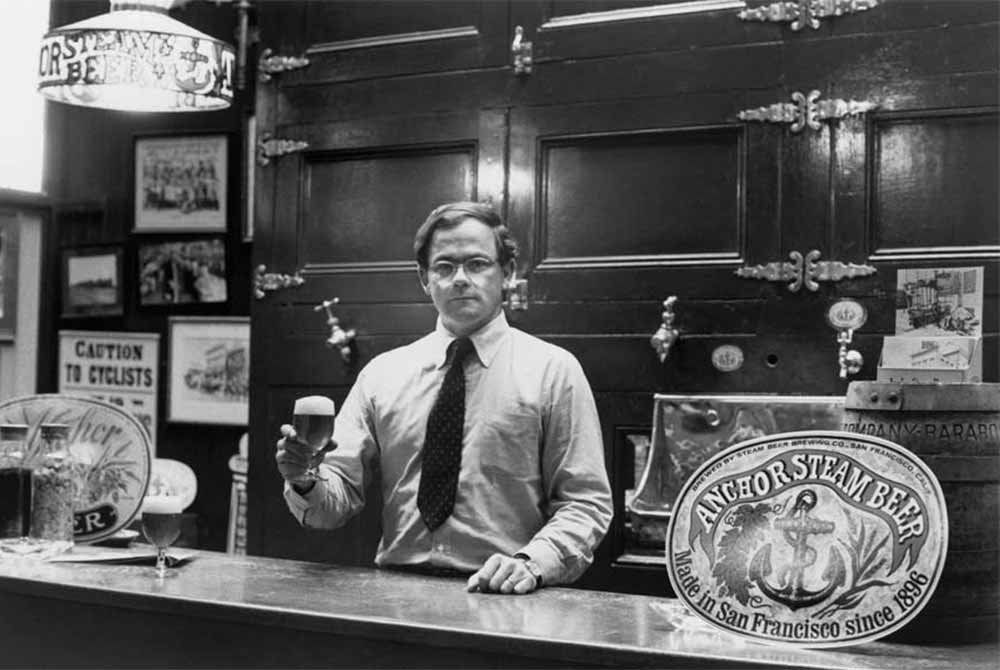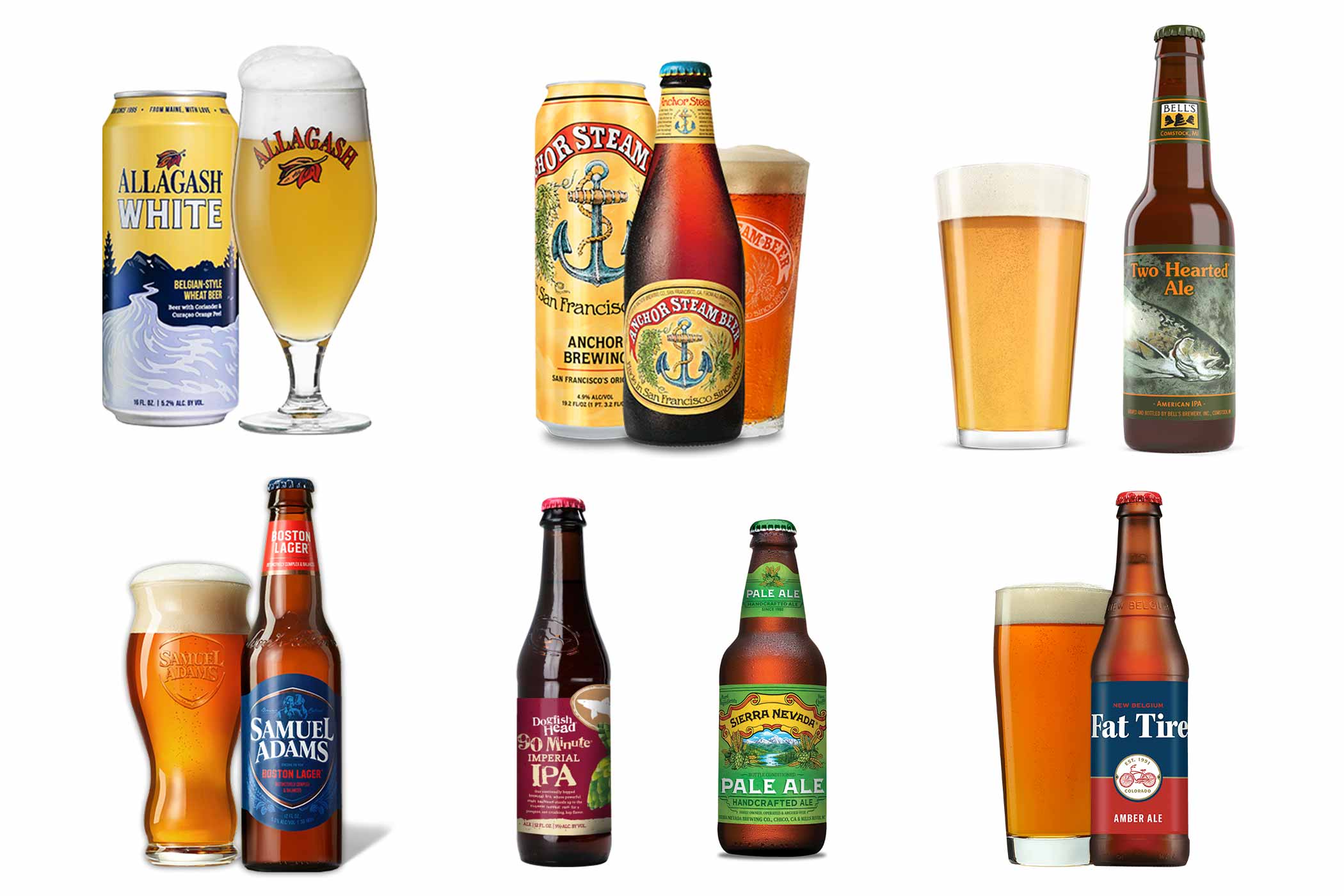Shop
Surviving Earthquakes, Fire, Prohibition, and Near Bankruptcy: Anchor Brewing Has Run on ‘Steam’ for More than 125 Years
A beer and brewery that have never run out of steam.
This is a paid, sponsored post presented by our friends at the Anchor Brewing.
If we asked you what makes San Francisco iconic, we imagine you’d mention a few things: cable cars, fog, and Anchor Steam® Beer.
You know that morning mist is as emblematic of this West Coast city as lakes are of Minnesota.
But what you might not know is that Anchor Steam Beer has become as tied to this town’s roots as, say, Pilsner Urquell in Plzeň, Czech Republic. Or Spaten Oktoberfest in Munich, Germany.
Look at the beating heart of San Francisco and you’re sure to see Anchor Steam Beer pumping in and out of its right and left ventricles.
Almost like a delicate ecosystem, the very climate endemic to this city helped create steam beer. And in return, steam beer became the life blood of this city.
Anchor Steam Beer in particular has survived fires, earthquakes, deaths of multiple owners, years of Prohibition, and threats of bankruptcy. Yet each and every time, this amber beer rose from the ashes.
Over 150 years, Anchor Brewing Company has evolved into a legendary brewery making many iconic beers.
But more so than any other, Anchor Steam Beer endured. This is the liquid gold that kept the pulse of this San Francisco brewery alive from the very beginning.
Anchor’s Early Years: A Gold Rush, a German Carpenter, and California Common Beer
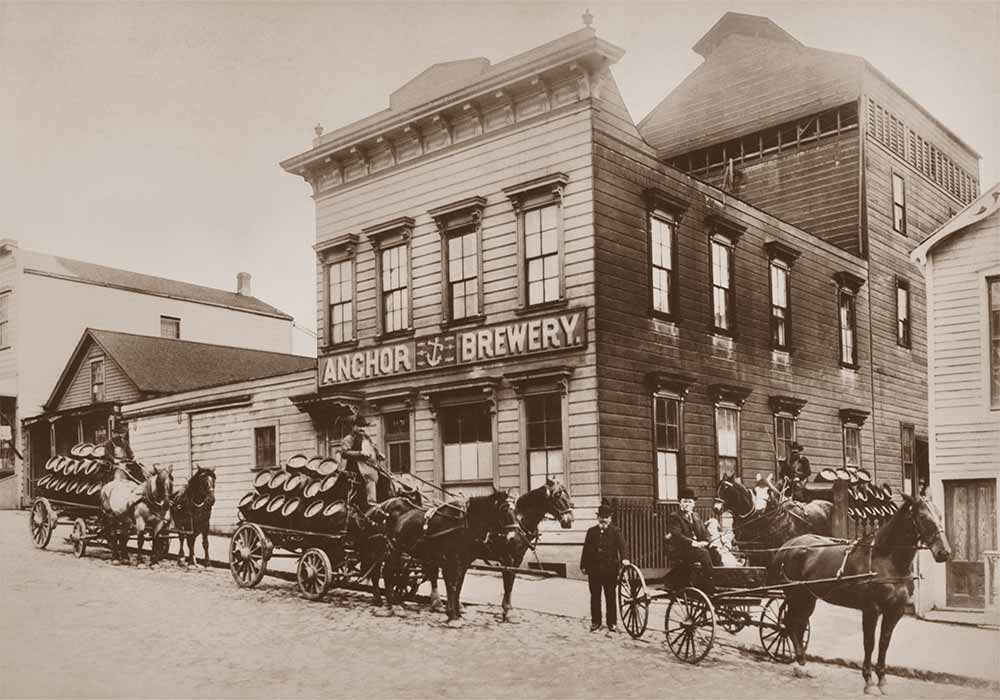
Anchor Brewery on Russian Hill ca.1905/06 | Photography courtesy of Anchor Brewing Company
James W. Marshall discovered gold on January 24th, 1848, on a property near Coloma, CA. What ensued became known as the Gold Rush. People literally rushed to the Western frontier for their chance at striking it rich.
Including Anchor Brewing Company’s first brewmaster Gottlieb Brekle. A German carpenter who came to San Francisco with his bride in 1853-1854, Brekle reinvented himself as a brewer.
In 1871, Brekle purchased a beer and billiards saloon in the Russian Hill area of San Francisco for $3,500, turning it into a brewery he named the Golden City Brewery.
In 1896, after several owners and name changes, Ernst F. Baruth and his son-in-law Otto Schnikel Jr. purchased the brewery.
The two made one incredibly important change: They renamed the business, Anchor Brewery.
During the Gold Rush, San Francisco’s brewers wanted to make what was the most popular style of beer at the time—lager.
But making lager on the West Coast wasn’t easy.
A Mountainous Climb to Brew Lager on the West Coast
Traditionally a German and European style of beer, lager actually translates from German as “to store.” A reference to the fact German brewers would put away these beers in cool locations like caves to ferment. Why? Because lager used a yeast that thrived in a cooler environment.
In mid-1800s Europe and America, if a brewer didn’t have a cave handy, they used a cellar cooled with ice. Because remember, modern refrigeration wouldn’t become commercially widespread until the late 1800s.
And while breweries on the East Coast had easy access to ice, Californians could only find it in the Sierra Nevada mountains. And even that ice couldn’t be shipped to the coast until after the completion of the Transcontinental Railroad in 1869.
So in San Francisco, brewers had to get creative. “Out here in these primitive conditions during the Gold Rush, what the heck were they going to do?” asks David Burkhart, Brewery Historian at Anchor Brewing Company, whose thirty-one years at the brewery led him to compile a book on Anchor’s history called The Anchor Brewing Story that will be released this November. “How were they going to make a lager beer?”
With a little bit of genius.
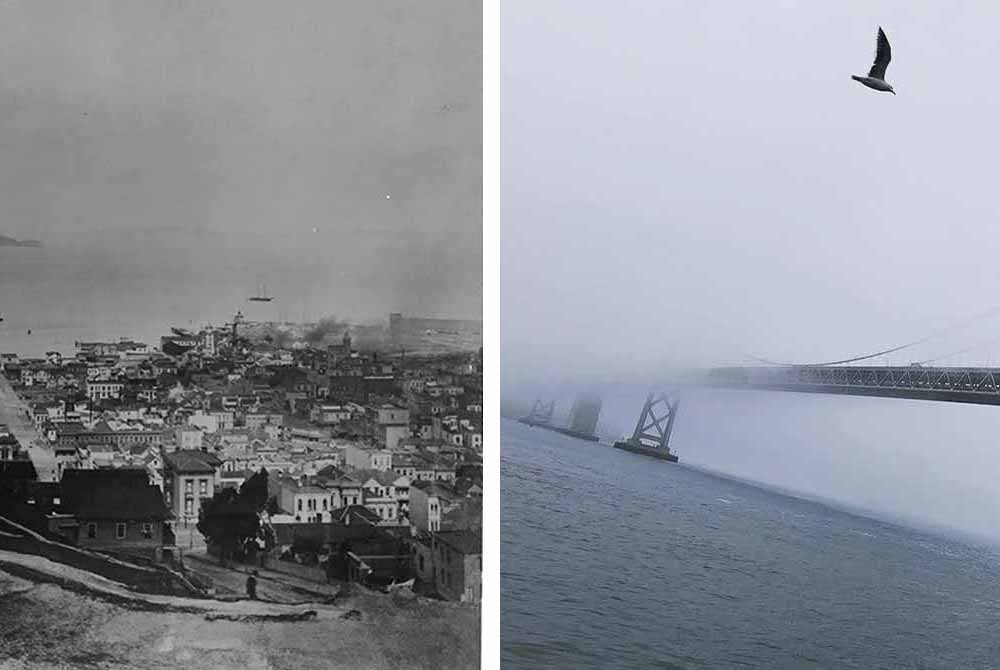
Cool, foggy, temperate climate of San Francisco then and now | Photography courtesy of Anchor Brewing Company (on the left) and @karlthefog (on the right)
A Short/Long History of Steam Beer
One of the only American-grown styles of beer, steam beer has a rich if not slightly murky history.
Technically classified as a California common, steam beer refers to a style of beer with a dominant malt foundation fermented at more ale-like temperatures, but brewed with lager yeast, resulting in a clean, crisp flavor profile.
But here’s what makes steam beer so fascinating: How the heck could San Francisco brewers ferment a beer at colder temperatures without caves or ice?
The answer becomes one of the backbones of steam beer.
San Francisco brewers may have been a “little short on ice, but they were long on ingenuity,” says Burkhart.
Quite simply, they used what they had around them. In other words, a foggy, temperate climate.
One of the clever ideas brewers came up with was to cool their beer in a large, open, shallow vessel called a coolship…on the roof or top floor of their breweries.
Here’s how it worked: After boiling the wort (unfermented beer), the liquid needed to cool before brewers could pitch (add) the yeast, which would not survive in high temperatures.
Accordingly, brewers would transfer the wort to those large shallow vessels to cool. On the top floor, the unfermented beer was exposed to the cool, mild San Francisco air through louvered windows.
“When the hot wort came in contact with the cold air, guess what?” says Burkhart. “Steam would waft from those louvers. If you looked up at a brewery back in those days, including ours, you would say, ‘Wow, that looks like steam coming out of the brewery.’”
Brewmaster Tom Riley, a thirty-eight-year veteran at Anchor Brewing Company, helps set the scene: “People coming into port or rolling around town would see steam coming off the top from these steam beer breweries.”
Almost creating a fog all its own, steam beer slowly seeped its way into the fabric of the city.
As Anchor Brewing Company Assistant Brewmaster Dane Volek put it, “It’s the beautiful and unique part of the process…that really sets steam beer apart.”
But that’s only one theory on the origin.
See, in all reality, the beer’s nickname is almost as opaque as, well, a San Francisco morning.
“We don’t know for sure,” says Burkhart. “I used to be frustrated with that, but now I think…the ironic beauty of it is we’ll never know.”
What Are the Other Potential Origins of Steam Beer?
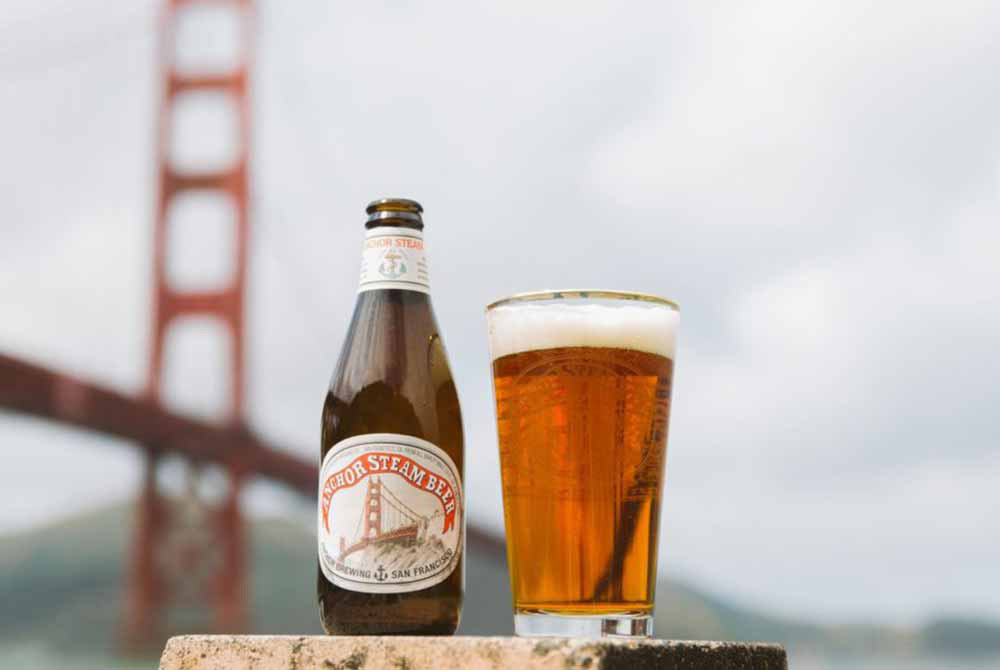
Anchor Steam® Beer | Photography courtesy of Spirited
Burkhart and Riley presented several other theories around the origin of the nickname steam beer. Each as interesting as the former.
For example, once the beer had fermented, brewers in San Francisco would transfer it directly to a wooden barrel for a secondary fermentation phase, forgoing the historical European practice of letting the beer rest in a cold alpine cave or cellar full of ice.
With the idea to get the beer in the market as quickly as possible and prevent spoilage, these barrels would go out as little as two or three days later in horse-drawn wagons bound for various San Francisco bars and restaurants.
When bartenders went to tap the kegs, they had to do so carefully, considering beer still happily fermented away inside. “If you had a warmer fermentation, it was faster and produced more CO2,” says Riley. “Well, think about that inside a closed barrel. You’ll build up a lot of pressure, so when you tapped into these things, it would hiss and foam kind of similar to a steam engine.”
Burkhart takes this story a step further. In those days, bartenders would often pour a pint from three different kegs in three different stages of fermentation to ensure the perfect “head of steam.” This buildup of foam on the head of a beer ensured all those essential aromas and flavors reached a patron’s nose and palette.
“‘Head of Steam’ became a nickname for the effervescent, beautiful head that would linger a long time in your glass,” says Burkhart.
Poetic and romantic, these theories all have their place as much as a more practical one Burkhart throws into the mix.
“[Steam] was also what I call a buzzword,” says Burkhart, who references how the word atomic became popular in the 1950s or the word digital caught on in the 1990s. “Steam power was big…so back in those days anything “steam” was all the rage. Even if a company had nothing to do with steam at all, companies wanted to associate with the word.” Burkhart points out that, if you looked through a city directory at the time, you would find steam bakeries, steam candy makers, steam everything, so it was entirely possible that steam beer was “just a little bit of early Gold Rush marketing,” says Burkhart.
We may never know the actual origin of steam beer, but honestly, that’s a part of its lore. And while the origin (and honestly steam itself) may be an elusive entity, steam beer has made an indelible mark on Anchor’s history.
How We Try to Condense Over 150 Years of Anchor’s History into 300 Words
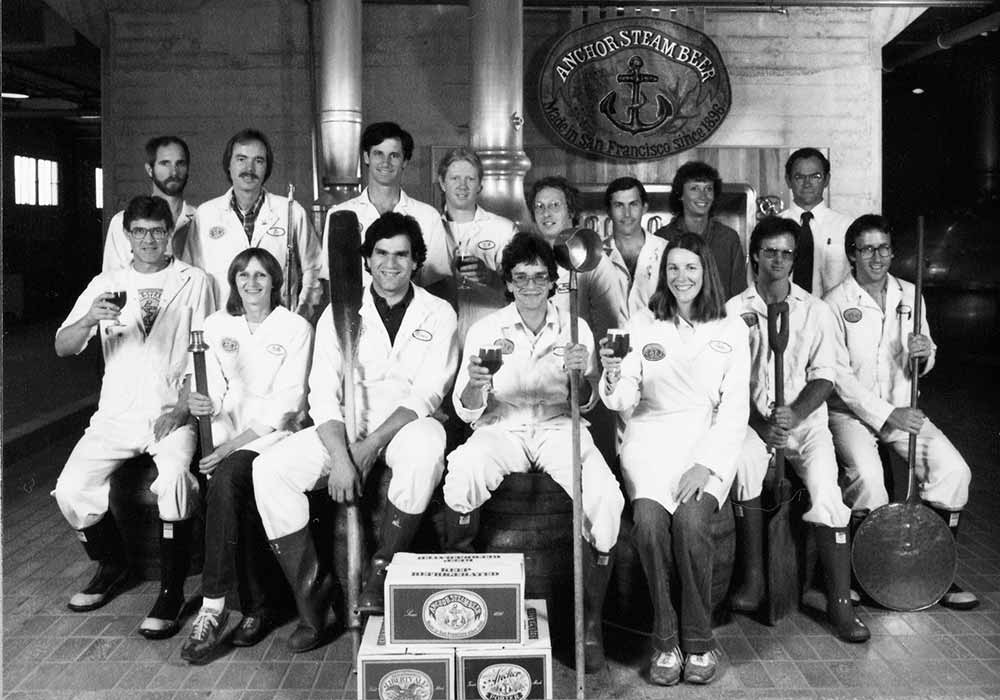
Anchor Brewing Company staff in the early days | Photography courtesy of Anchor Brewing Company
Really we only need one word: Steam.
It’s wits and ingenuity that crafted steam beer, making it an eloquent representation of Anchor Brewing as a brewery.
Because delve into the history of this 151-year-old brewery and you’ll find more ups and downs than a stretch of street in San Francisco.
If we had to boil it down, this is Anchor’s history: fires, earthquakes, Prohibition, near bankruptcy (a couple of times), survival, steam.
Throughout all these disasters Anchor Steam Beer prevailed.
Anchor seems to have always been powered by its own steam. Or has it been Anchor Steam Beer that’s always powered Anchor?
How Anchor Brewing Became Tied to Anchor Steam Beer
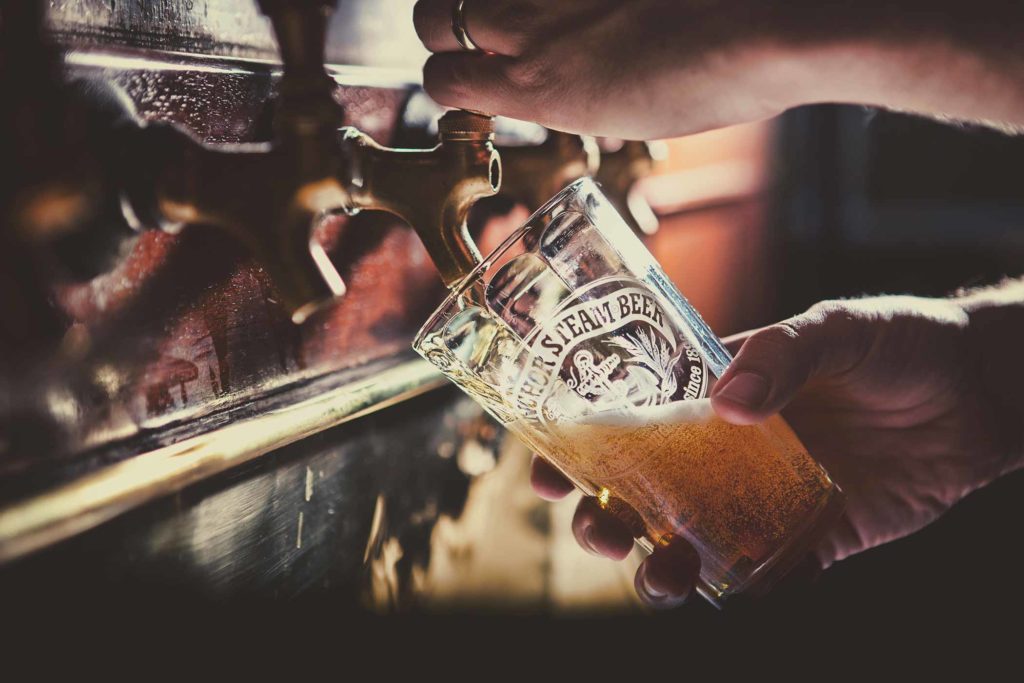
Anchor Steam Beer | Photography courtesy of Anchor Brewing Company
Although the brewery started with Brekle in 1871, it wasn’t until twenty-five years later under the ownership of Ernst F. Baruth and his son-in-law Otto Schnikel Jr. that the name became Anchor Brewing Company.
So while the brewery has been producing steam beer since the 1870s, the beer didn’t technically become Anchor Steam Beer until close to the turn of the century (which is why Anchor “only” celebrated the 125th anniversary of Anchor Steam Beer last year, but simultaneously that year celebrated the 150th anniversary of the entire brewery).
Sadly, from there the history of Anchor skews into a series of unfortunate events. Baruth died suddenly on Valentine’s Day in 1906, and a fire destroyed the brewery two months later after San Francisco’s great earthquake. Less than a year later, Schnikel Jr. died when a streetcar ran him over in January of 1907.
Brewmaster Joseph Kraus kept Anchor alive until a little thing called Prohibition shut down the brewery for thirteen years.
Yet, when President Franklin D. Roosevelt repealed Prohibition in 1933, Anchor came back from the ashes.
“We’re very much a phoenix,” says Riley.
In fact, Kraus picked up right where he left off. And as far as Burkhart can tell from his research, Kraus is the only brewmaster to perform that feat—straddling Prohibition as owner/brewmaster with the same brewery, “a great example of the unbroken continuity of our history,” says Burkhart.
But again, just after reviving Anchor Steam Beer from a thirteen-year hiatus, the newly opened Anchor burned down in February of 1934.
Kraus rebuilt the brewery with a new partner, Joe Allen, and Anchor seemed to chug along until Kraus’ death in 1952. By late 1959, America’s love of mass-produced lagers had led to Anchor’s declining sales, forcing the aging Allen to close the brewery.
Less than a year later, Lawrence Steese bought and reopened Anchor. But Anchor continued to struggle and, just five years later, Steese was forced to consider shutting down the brewery.
Again, Anchor faced certain extinction.
Until August 1, 1965, when a young Stanford graduate by the name of Fritz Maytag heard of his favorite brewery’s imminent demise while enjoying dinner and an Anchor Steam Beer at the Old Spaghetti Factory.
Fritz Maytag Saves Anchor and Anchor Steam Beer
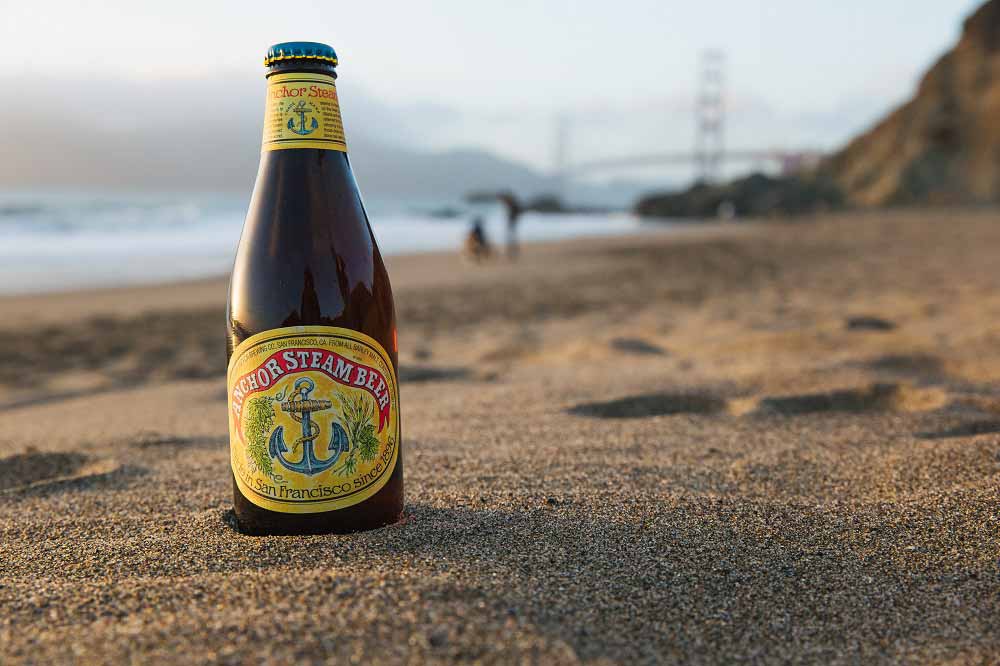
Anchor Steam Beer | Photography courtesy of Anchor Brewing Company
The very next day—on August 2nd, 1965—Maytag, the great grandson of the founder of the eponymous washing machine empire, visited Anchor Brewing for the first time.
That same day, he agreed to buy a fifty-one percent stake in this historic brewery.
So many times Anchor seemed on the brink of collapsing into oblivion, and yet the brewery and Anchor Steam Beer survived.
Was it coincidence then that I just happened to interview Burkhart on August 2nd, 2022, literally fifty-seven years to the day when Maytag made his fateful decision?
Burkhart’s first words were, “Today is one of the most momentous days in craft brewing history because today celebrates the fifty-seventh anniversary of Fritz Maytag’s historic visit to Anchor Brewing Company.”
We couldn’t make up these stories if we tried!
“At that time, he was only thinking of himself as an angel who flew in to save the day, not, ‘oh my gosh, I want to become a brewer.’”
That would come later.
Maytag Revolutionizes Anchor’s Brewing Philosophy
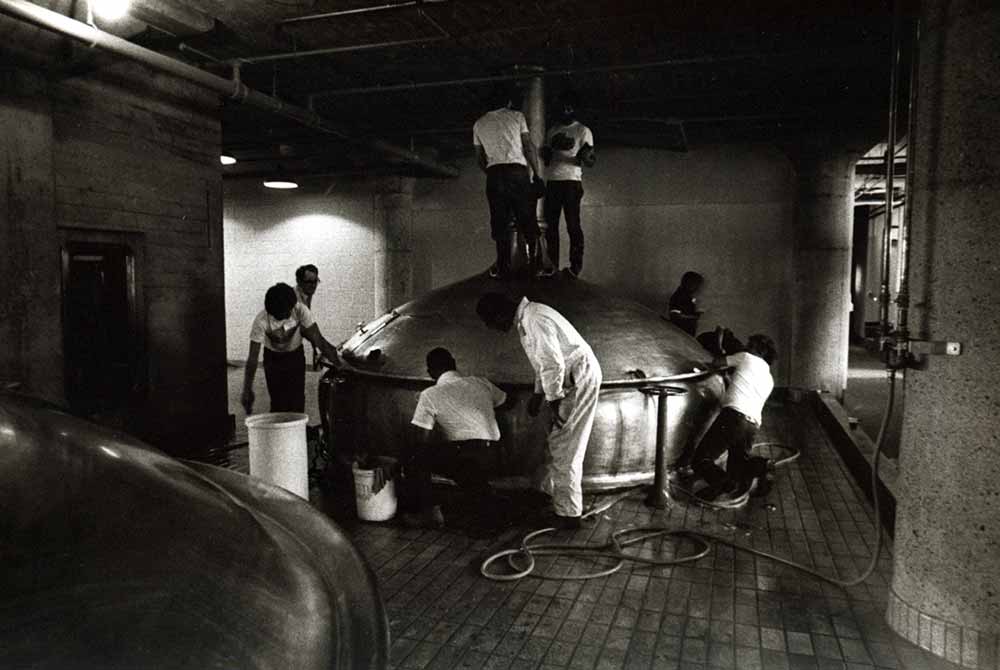
Anchor Brewing Company polishing party | Photography courtesy of Anchor Brewing Company
While Anchor Steam Beer has always been romanticized as a historical beer, there’s no denying that it wasn’t always the most consistent when it came to quality.
It’s a sore point that plagued Maytag, eventually sending him down a rabbit hole.
Burkhart recounts one story that became the final straw. In the 1960s, before a big party at the brewery, Maytag went to the taproom to taste the beer, but found it had soured. So he got in his car and drove all over town looking for a good keg of Anchor Steam Beer. Finally, stopping at Artichoke Joe’s, he discovered an acceptable one, literally buying it back from the bartender and bringing it to the brewery.
“He decided that day, that’s enough,” says Burkhart. “I have to worry a bit less about getting the beer out there and a little bit more about getting the beer to be better.”
Accordingly, Maytag purchased Jean de Clerck’s A Textbook of Brewing, a two-volume book about how to brew and how to analyze what you brewed, and began teaching himself all about beermaking.
Even going so far as to bring in a microscope he had had since the age of fifteen, to scrutinize the beer Anchor had been producing. “He got a chance to look at all the little bacteria swimming around in his product back in those days,” says Burkhart.
From then on, Maytag became obsessed with brewing more consistent, higher-quality beer.
A philosophy he realized had been ingrained in him thanks to his family’s journey to build one of the most revered appliance companies on the planet. (Funny to think, if Maytag refrigerators had been around in the mid-1800s, we might not even have steam beer as we know it today).
Refrigerators May Not Have Helped Steam Beer, But They Helped Maytag
“What’s the word that comes to mind when you think of Maytag?” Burkhart asks me.
“Quality and consistency,” I reply.
“Surprise! Surprise!,” says Burkhart. Maytag wanted to not only make great beer, but he wanted to make it over and over and over again. “One of the keys to a successful beer is not just making one great batch of beer, but making it time and again,” says Burkhart.
And Maytag wanted to start with Anchor Steam Beer.
Maytag Revolutionizes Anchor Steam Beer
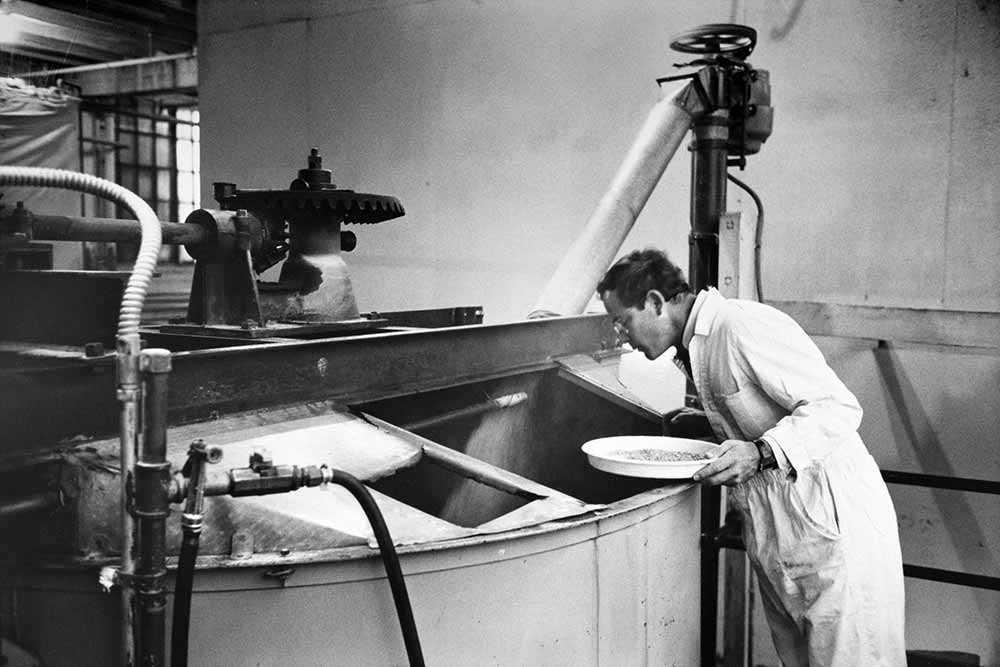
Fritz Maytag looking into a mash tun | Photography courtesy of Anchor Brewing Company
To increase the quality and consistency of Anchor Steam Beer, Maytag refined and perfected the recipe. Previously, the brewery’s financial woes had led to cutting corners on raw materials. When Fritz bought the brewery, for example, Anchor Steam Beer was no longer made from all barley malt. and its characteristic amber tint, if it was amber at all, often came from caramel coloring.
Maytag changed all that, incorporating an all-malt bill of 2-Row Pale and Caramel malt, which gave the beer that gorgeous garnet hue.
Previously, Anchor Steam Beer had included whatever hops were available, often Cluster, a popular bine at the time.
Maytag changed that too, incorporating Northern Brewer hops, a relatively new hop at the time. “In those days, Cluster was a common hop among breweries and he wanted to make an uncommon California common,” laughs Burkhart.
Maytag could make changes because he wasn’t necessarily tied down to a single recipe. “There was no recipe in a vault from 1858 or whatever that he had to rely on,” says Burkhart.
But beyond the recipe, perhaps the most important change Maytag made included upgrading the brewery’s equipment to all stainless steel (except for the copper brew kettle).
A concept foreign to most American brewers at the time, an all-stainless-steel, cleaned-in-place operation improved the beer’s quality by light years because, as most of us know, “the key to making good beer is sanitation,” says Burkhart.
It’s these types of innovations that became the hallmark of Maytag’s ownership. “He was not what I call an ambulance chaser; he blazed his own trail and did whatever he wanted,” says Burkhart. “Fritz likes to say that, ‘we had the world by the tail. The world just didn’t know it yet.’”
Well, we certainly know now.
What Makes Anchor Steam Beer so Iconic Today?
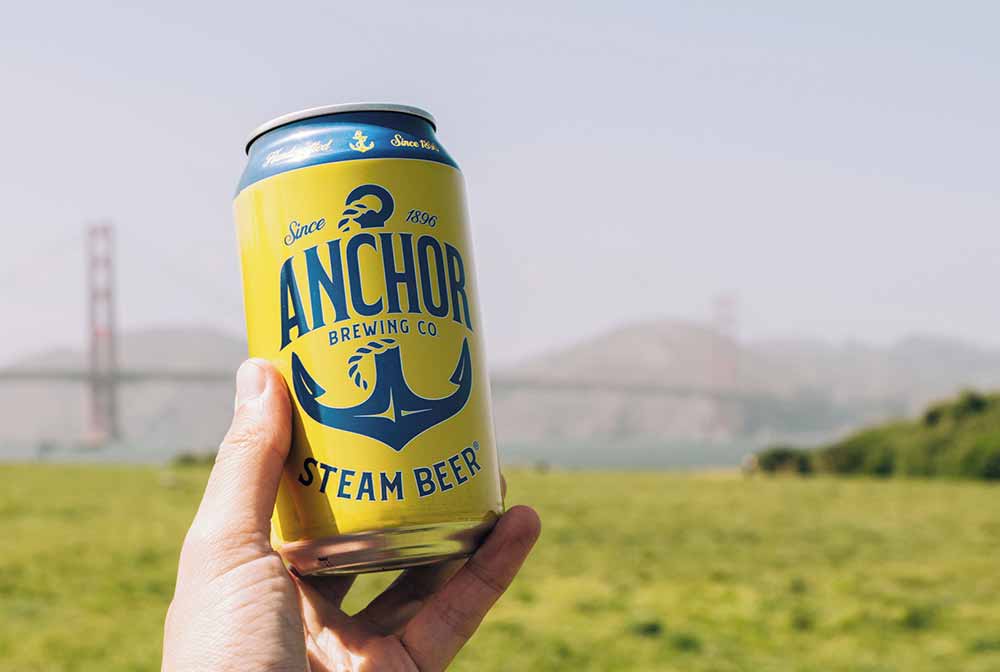
Photography courtesy of Anchor Brewing Company
When we think of Anchor Steam Beer today, it is one of the most iconic beers in America.
So how did a beer brewed on rooftops that almost went six feet under…multiple times…reach such prestige?
First and foremost, Anchor Steam Beer has a romantic connection to San Francisco and the city’s history. “Steam for me is a hometown hero,” says Volek.
Riley, who was born and raised in San Francisco agrees, “This company is as much a part of the fabric of San Francisco as I am.”
It’s a beer that truly and authentically represents this major West Coast town as much as cioppino or cable cars.
“I’ve always said that if that Sunday, August 1st, someone told Fritz that they were about to shut down the last cable car in San Francisco, he would have hopped in his car the next day just like he did for Anchor Steam and figured out a way to rescue cable cars,” says Burkhart. “That beer is so identified with this city.”
Survival stays at the root of Anchor Steam. Much as San Francisco itself has survived earthquakes, fires, and more. It seems like every time this beer was resurrected, the city itself found new life.
It also doesn’t hurt that, since the late 1930s, Anchor has been the only brewery to make a California common. And to use the name “steam,” an Anchor trademark.
Anchor Steam Beer became the beer synonymous with steam beer. “Even today, when I walk into a bar in San Francisco and say, ‘I’ll have a steam,’ they know what I mean,” says Burkhart.
Lastly, thanks to Maytag’s innovations, it’s just a damn fine beer every time you drink it.
Tasting Through Anchor Steam Beer
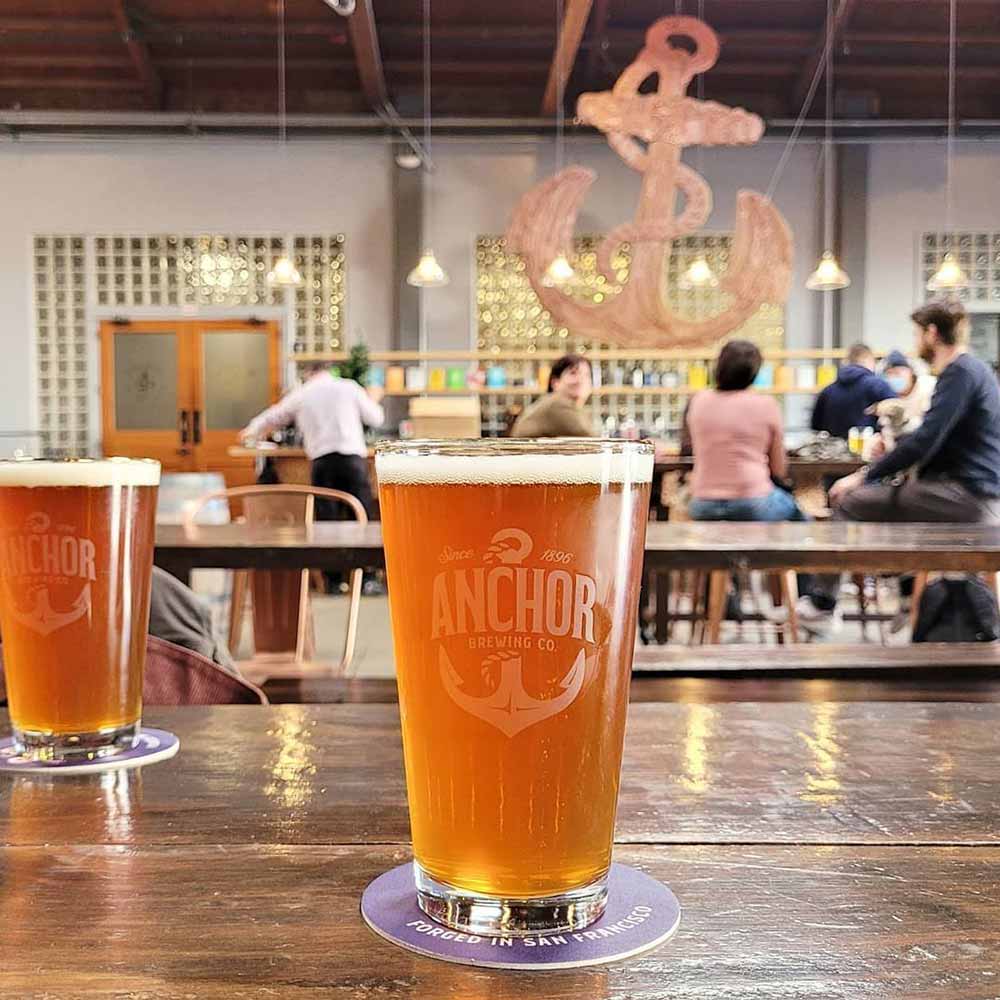
Photography courtesy of Anchor Brewing Company
Anchor Steam Beer has a unique color, aroma, and taste.
When you pour Anchor Steam Beer into a glass, you’ll immediately notice its color. “I love that beautiful copper hue,” says Volek. “The color was always really attractive to me with a nice, thick, creamy head… It’s a beautiful beer that definitely makes you think of beer when you see it.”
That richness carries through Anchor Steam Beer to its taste and aroma. In the body, you’ll find a “classic woodiness, a little herbaceous and wild flowery notes,” according to Volek.
While on the palette you’ll find “that balance of bitterness and sweetness… I always say it has a real beer flavor to me,” says Volek. “It’s something that is full and rich.”
A sentiment Riley echoes, “It’s an unpretentious beer in a classic style.” But to Riley the real ‘X’ factor comes from the fruity esters produced by the yeast.
Back in the day, when Anchor didn’t have a consistent brewing schedule, Riley says they couldn’t re-pitch (or re-use) yeast. Instead, Maytag would venture to different breweries around town asking them for a pitchable amount of yeast. “We’re not sure which yeast ended up living here,” says Riley. “But one ended up being our home yeast.”
A yeast that became unique to Anchor, adapting over time to the one we find in Anchor Steam today. “Yeast acclimates to its environment,” says Riley. “The cells in there that like the environment the most will procreate the most; it’s a process of who’s the happiest in the bath.”
Today, Anchor’s yeast gives Anchor Steam Beer a nice fruity complexity. But more than that, it’s given the beer terroir, the characteristic taste and flavor of its own environment. Literally, Anchor’s yeast has the essence of San Francisco running through its body.
A beer that’s withstood the test of time forever has the time of San Francisco in every batch of beer.
“I call it the extraordinary everyday beer,” says Burkhart. “In other words, I never get tired of it; it’s history in a glass, yet it never grows old.”
Especially now, when every year San Francisco hosts its own tribute to Anchor Steam Beer through Anchor Steam Week.
Anchor Steam Week
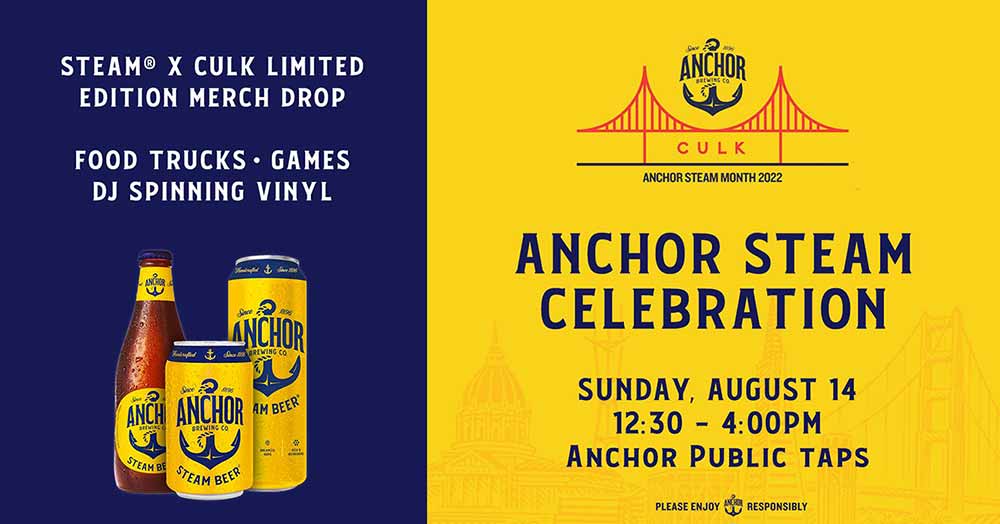
Graphic courtesy of Anchor Brewing Company
In 2015, San Francisco Mayor Ed Lee proclaimed the third week in August Anchor Steam Week.
A time to celebrate this pioneering beer and brewery’s history, Anchor Steam Week usually involves a series of special Anchor Steam Beer tappings at Anchor’s pilot taproom, Anchor Public Taps.
This year, Volek says we can look forward to three to five different Steam variants. They include: a darker Vienna-like lager fermented with Steam yeast, a barreled imperial Steam beer, and a high-gravity Steam.
Past iterations have even included a smoked Steam beer and an unfiltered Steam.
Overall, Anchor Steam Week is a time to reflect and celebrate. “We’ve literally grown up with San Francisco,” says Riley. “We’re the bedrock of this city.”
And Anchor will continue to be an…anchor in San Francisco and around the country for years to come.
What Does the Future Look Like for Anchor Steam Beer?
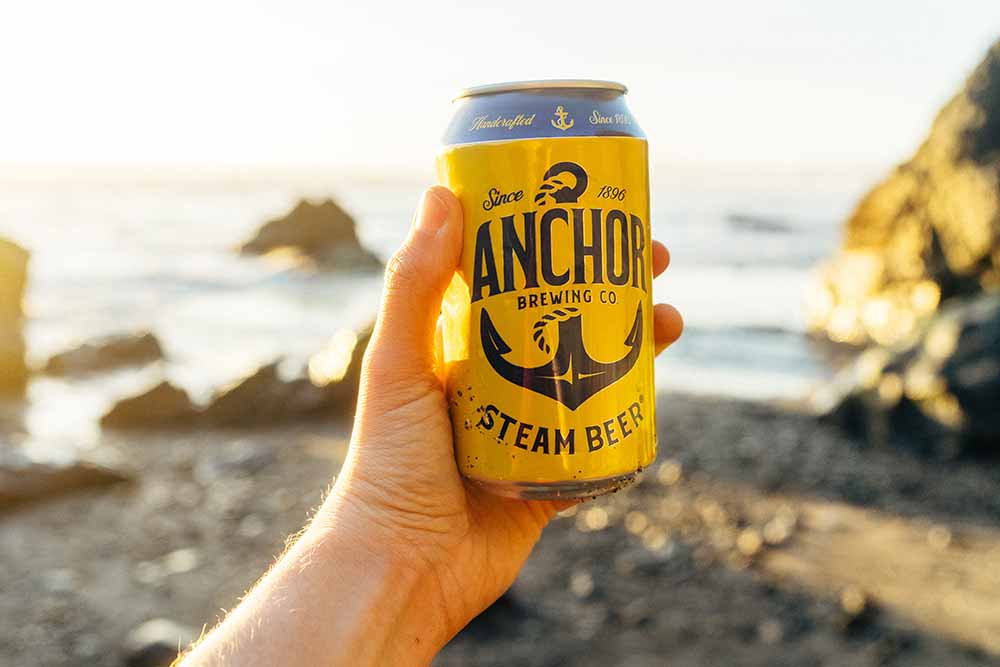
Photography courtesy of Anchor Brewing Company
For a beer that’s almost gone extinct several times, the future of Anchor Steam Beer looks strong.
Thanks in part to Maytag’s dedication to consistency and quality.
Improving Anchor Steam Beer has been an evolution. “From beer being made during California’s Gold Rush, it has evolved over the years and continues to get better,” says Burkhart. “We’ve married one of Fritz’s big innovations, modern technology, with two of his secrets, traditional methods and ingredients.”
A heritage and habit that Riley, Volek, and the entire Anchor Brewing team have carried on over the years.
“Steam Beer right now has never been better, never been fresher, and the quality has never been higher,” says Volek. “We’re keeping our eyes on the prize and working as hard as we can to make Steam Beer better and better every day.”
Volek and Riley may have their eyes on the future. But Burkhart reminds us that we can’t see where we’re going if we don’t know where we’ve been.
“Just think about all the blood, sweat, and tears that went into Anchor Steam throughout its history and the fact you’re drinking Anchor Steam and it survived!” says Burkhart. “There are so many points in the brewery’s history when that could have been it, it could have been over, whether because of a fire, Prohibition, bankruptcy, or whatever, and miraculously we’re still around.”
We’ll certainly raise an Anchor Steam Beer to that. Whether it’s during Anchor Steam Week or a random Tuesday this year or another 150 years from now.

